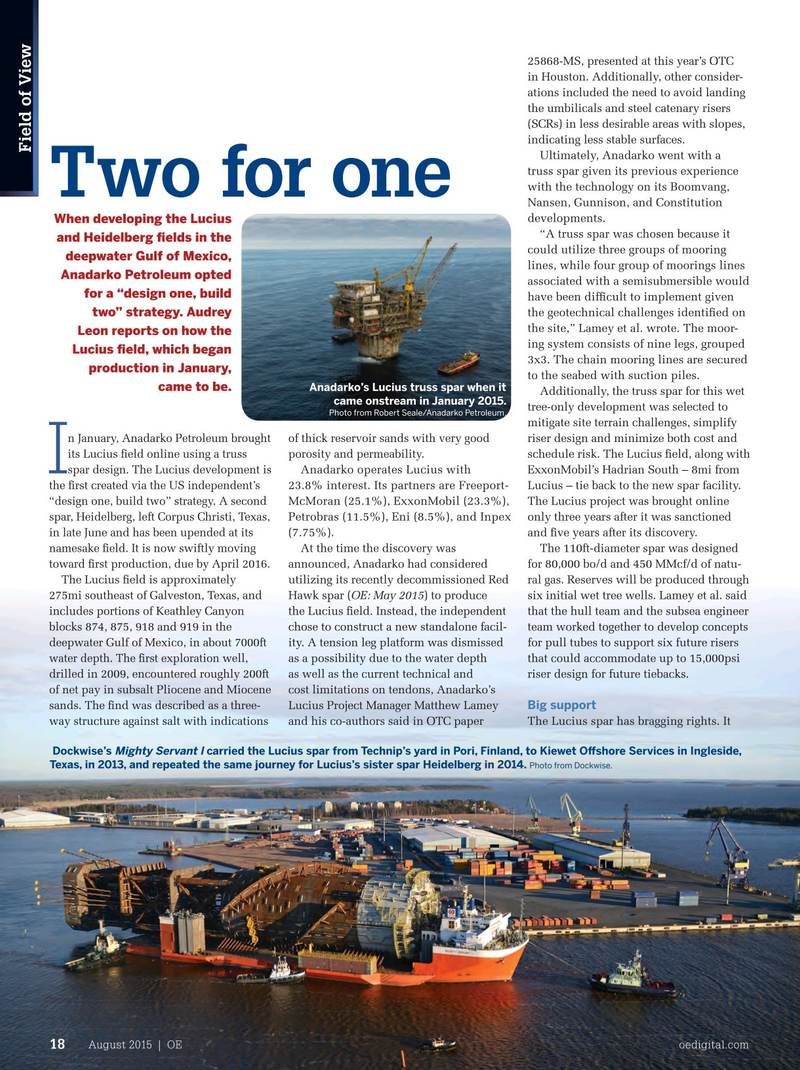
Page 16: of Offshore Engineer Magazine (Aug/Sep 2015)
Read this page in Pdf, Flash or Html5 edition of Aug/Sep 2015 Offshore Engineer Magazine
25868-MS, presented at this year’s OTC is often referred to as Anadarko’s largest in Houston. Additionally, other consider- spar built to date by the contractors that ations included the need to avoid landing worked on the development. It is obvious the umbilicals and steel catenary risers this massive project would need assis- (SCRs) in less desirable areas with slopes, tance from the world’s largest support indicating less stable surfaces. vessels.
Field of View
Ultimately, Anadarko went with a In 2011, Technip was chosen to provide truss spar given its previous experience engineering, construction, and transpor- with the technology on its Boomvang, tation of the Lucius spar hull. A second
Two for one
Nansen, Gunnison, and Constitution contract followed in 2012, for the devel- developments. opment of the Lucius ? eld. The scope
When developing the Lucius “A truss spar was chosen because it of work included the installation of one and Heidelberg ? elds in the could utilize three groups of mooring ? exible ? owline, multiple ? exible gas lift deepwater Gulf of Mexico, lines, while four group of moorings lines jumpers; main gas lift and in? eld umbili-
Anadarko Petroleum opted associated with a semisubmersible would cals; subsea distribution units; electrical, for a “design one, build have been dif? cult to implement given ? ber optic and hydraulic ? ying leads. the geotechnical challenges identi? ed on It also called for the design and fabrica- two” strategy. Audrey the site,” Lamey et al. wrote. The moor- tion of the ? exible ? owline end termina-
Leon reports on how the ing system consists of nine legs, grouped tion, fabrication and installation of rigid
Lucius ? eld, which began 3x3. The chain mooring lines are secured jumpers, burial of ? owlines, ? ooding and production in January, to the seabed with suction piles. hydro-testing of the ? owline system. came to be.
Anadarko’s Lucius truss spar when it
Technip’s deepwater pipelay vessel Deep
Additionally, the truss spar for this wet came onstream in January 2015.
Blue was used for installation work at the tree-only development was selected to
Photo from Robert Seale/Anadarko Petroleum.
? eld alongside sister vessel, Deep Energy.
mitigate site terrain challenges, simplify n January, Anadarko Petroleum brought of thick reservoir sands with very good riser design and minimize both cost and Hereema Marine Contractor’s then- its Lucius ? eld online using a truss porosity and permeability. schedule risk. The Lucius ? eld, along with newbuild Aegir’s ? rst job was to install
I
Anadarko operates Lucius with ExxonMobil’s Hadrian South – 8mi from risers and ? owlines at the Lucius ? eld, spar design. The Lucius development is 23.8% interest. Its partners are Freeport- Lucius – tie back to the new spar facility. while the deepwater construction vessel the ? rst created via the US independent’s
McMoran (25.1%), ExxonMobil (23.3%), The Lucius project was brought online (DCV) Balder handled the hull and moor- “design one, build two” strategy. A second
Petrobras (11.5%), Eni (8.5%), and Inpex only three years after it was sanctioned ing commissioning. HMC’s semisubmers- spar, Heidelberg, left Corpus Christi, Texas, (7.75%). and ? ve years after its discovery. ible crane vessel Thalif, capable of lifting in late June and has been upended at its
At the time the discovery was The 110ft-diameter spar was designed 14,200-tonne (15,600-ton), was tasked namesake ? eld. It is now swiftly moving announced, Anadarko had considered for 80,000 bo/d and 450 MMcf/d of natu- with Lucius’ topsides installation. The toward ? rst production, due by April 2016.
The Lucius ? eld is approximately utilizing its recently decommissioned Red ral gas. Reserves will be produced through facility weighed an initial 15,000-ton, 275mi southeast of Galveston, Texas, and
Hawk spar (OE: May 2015) to produce six initial wet tree wells. Lamey et al. said however, the job was broken into nine includes portions of Keathley Canyon the Lucius ? eld. Instead, the independent that the hull team and the subsea engineer lifts, the heaviest of which was 10,250- blocks 874, 875, 918 and 919 in the chose to construct a new standalone facil- team worked together to develop concepts ton (OE: October 2013).
7000ft deepwater Gulf of Mexico, in about ity. A tension leg platform was dismissed for pull tubes to support six future risers Allseas’ massive pipelayer Solitare was well, water depth. The ? rst exploration as a possibility due to the water depth that could accommodate up to 15,000psi used to install an 18in oil export pipe- drilled in 2009, encountered roughly 200ft as well as the current technical and riser design for future tiebacks. line, while Saipem’s Casterone handled of net pay in subsalt Pliocene and Miocene cost limitations on tendons, Anadarko’s the installation of a 20in gas export line.
Big support sands. The ? nd was described as a three-
Lucius Project Manager Matthew Lamey Allseas’ Audacia installed an oil export way structure against salt with indications and his co-authors said in OTC paper The Lucius spar has bragging rights. It pipeline end termination in Keathley
Canyon 831.
Dockwise’s carried the Lucius spar from Technip’s yard in Pori, Finland, to Kiewet O

 15
15

 17
17